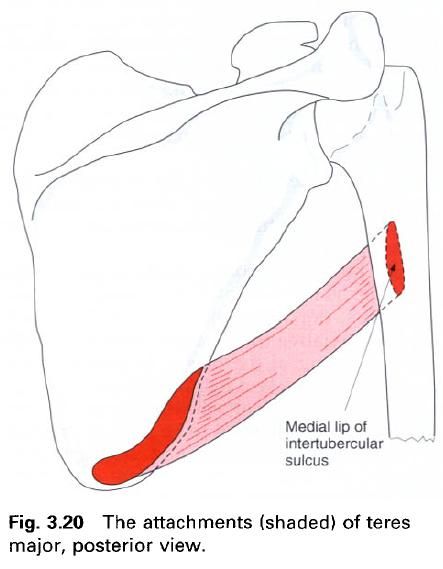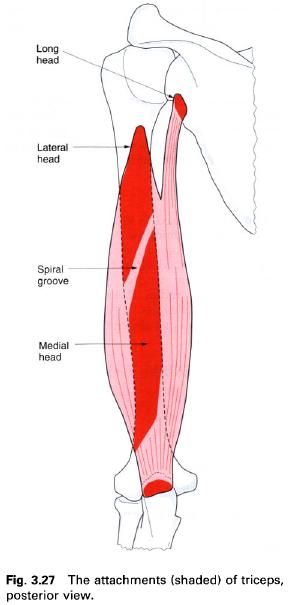Latissimus dorsi
Teres major
Triceps(long head)
Latissimus dorsi
Latissimus dorsi is a large flat triangular
sheet of muscle running between the trunk, via an extensive attachment, and the
humerus by a narrow tendon. Consequently, it acts on the shoulder joint. The
superior surface of the muscle forms the lower border of the triangle of
auscultation, while its lateral border forms the medial border of the lumbar triangle.
Latissimus dorsi arises from the posterior
layer of the thoracolumbar fascia,
which attaches to the spinous processes
of the lower six thoracic and all of the lumbar and sacral vertebrae,
as well as to the intervening supraspinous
and interspinous ligaments.
That part arising from the lower six thoracic
vertebrae is covered by trapezius. In
addition to this vertebral attachment, latissimus dorsi arises from the
posterior part of the outer lip of
the iliac crest, most laterally by
direct muscular slips. As the muscle fibres sweep upwards and laterally across
the lower part of the thorax, they attach to the outer surfaces of the lower
three or four ribs and via fascia
to the inferior angle of the scapula. From this widespread origin the
fibres converge as they pass to the humerus
and form a thin flattened tendon. The tendon winds around and adheres to
the lower border of teres major, and inserts into the floor of the intertubercular
groove anterior to the tendon of teres major, being separated from it by a
bursa. The effect of twisting the muscle through 180° means that the anterior
surface of the tendon is continuous with the posterior surface of the rest of
the muscle. Consequently, the fibres with the lowest origin on the trunk gain
the highest attachment on the humerus.
Nerve
supply
Latissimus dorsi is supplied by the thoracodorsal nerve, root value C6, 7,
8, which enters the muscle on its deep surface. The skin covering the muscle is
supplied by roots T4 to T12 inclusive, by both ventral and dorsal rami, and L1
to L3 by the dorsal rami.
Action
Latissimus dorsi is a strong extensor of the
flexed arm; however, if the humerus
is fixed relative to the scapula it
retracts the pectoral girdle. It is also a strong adductor and medial rotator
of the humerus at the shoulder joint.
Functional
activity
Functionally, latissimus dorsi is a climbing
muscle, and with the arms fixed above the head it can raise the trunk upwards,
in conjuction with pectoralis major.
Latissimus dorsi has an important function in rowing and during the downstroke
in swimming. Attachment of the muscle to the ribs means that it is active in
violent expiration, and can be felt pressing forcibly inwards during a cough or
sneeze, as it acts to compress the thorax and abdomen.
The attachment to the inferior angle of the scapula allows latissimus dorsi to
assist in holding it against the thorax during movements of the upper limb.
If the humerus
becomes fixed point when standing, as for example when using crutches,
latissimus dorsi is able to pull the trunk forwards relative to the arms;
associated with this is a lifting of the pelvis. In patients with paralysis of
the lower half of the body, the fact that latissimus dorsi attaches to the
pelvis and is still innervated allows it to be used to produce movement of the
pelvis and trunk. Consequently, patients wearing calipers and using crutches
can produce a modified gait by fixing the arms and hitching the hips by the
alternate contraction of each latissimus dorsi.
Palpation
In a lean subject, latissimus dorsi can be made
to stand out relative to the thorax by asking the subject to raise his or her
arm to 90° flexion and to hold it steady against an upwardly directed pressure.
The muscle can be felt contracting if the posterior axillary fold is held
between the finger and thumb while the subject coughs. Adduction of the
abducted arm against resistance also enables latissimus dorsi to be seen and
felt.
Teres major
In the posterior part of the axilla, teres
major forms the lower boundary of both the upper triangular and quadrangular
spaces. It is a thick, chunky muscle, forming, with latissimus dorsi, the
posterior fold of the axilla. It arises from an oval area on the dorsal surface of the scapula near the inferior angle, and from the fascia
between it and adjacent muscles. The muscle fibers, which adhere to those of
latissimus dorsi, run upwards and laterally to form a broad, flat tendon which
attaches along the medial lip of the intertubercular groove. The tendon is
separated from that of latissimus dorsi by a bursa, with the latter muscle
virtually covering the whole of teres major.
Nerve
supply
Teres major is supplied by the lower subscapular nerve, root value C6
and 7.
Action
Teres major adducts and medially rotates the humerus at the shoulder joint. In
addition it can help to extend the flexed arm.
Functional
activity
Teres major, like latissimus dorsi, is a
climbing muscle and works with the latter and pectoralis major to pull the
trunk upwards when the arms are fixed. In conjunction with latissimus dorsi and
pectoralis major, teres major is
important in stabilizing the shoulder joint.
Palpation
Teres major is covered by latissimus dorsi, and
as these two muscles have similar actions, considerable care must be exercised
when it is tested. The inferior angle of the scapula must first be found, the fingers are then moved upwards and
laterally into the posterior wall of the axilla. The subject should abduct the
arm to 90° and then adduct against an upwardly directed resistance. The rounded
contour of teres major should now be palpable. During this same manoeuvre the
flattened tendon of latissimus dorsi, as it twists around teres major, may also
be felt.
Triceps brachii
Triceps brachii is situated on the back of the
arm and, as suggested by its name, arises by three heads. Two of the heads
arise from the humerus, being
separated by the spiral groove, and the third comes from the scapula. The three heads are reffered to
as: the long head, lateral head and medial head. The muscle attaches via a
tendon of the ulna.
Long
head. The tendinous long head
comes from the infraglenoid tubercle
of the scapula and the adjacent glenoid labrum, where it blends with the
lower part of the shoulder joint capsule. Named after its length, the long head
is also the most medial of the three, the fibres running downwards superficial
to the medial head before joining the tendon of insertion. As the long head
descends from the infraglenoid tubercle, it passes between teres minor, to
which it is anterior, and teres major, to which it is posterior. In its course
it forms the medial border of the quadrilateral and lower triangular spaces,
and the lateral border of the upper triangular space.
Lateral
head. The fleshy lateral head
arises above and lateral to the spinal groove
on the posterior surface of the humerus between the attachments of teres
minor and deltoid. As the fibres pass
to join with those of the medial head, they cover the spiral groove.
Medial
head. The large, fleshy medial
head lies deep of the other two, and arises from the posterior surface of the humerus,
below and medial to the spiral groove
as far distally as the olecranon fossa. It has an additional attachment to the
posterior aspect of the medial and lateral intermuscular septa.
The three heads of triceps come together to
form a broad, laminated tendon; the superficial part of which covers the
posterior aspect of the lower third of the muscle, while the deeper part arises
from within the substance of the muscle. Such an arrangement creates a larger
surface area for the attachment of the muscle fibres. Both laminae blend to
form a single tendon which attaches to the posterior
part of the proximal surface of
the olecranon of the ulna, and to the deep fascia of the forearm
on either side. Some muscle fibers from the medial head attach to the posterior
part of the capsule of the elbow joint and serve to pull it clear of the moving
bones and prevent it becoming trapped during extension of the joint.
Nerve
supply
All three parts of the muscle are supplied
separately by branches from the radial
nerve. The branch to the lateral head is derived from C6, 7 and 8, while
those to the long and medial heads come from C7 and 8. Of these, the medial
head receives two branches, one of which accompanies the ulnar nerve for a
considerable distance before entering the distal part of the muscle. The other
branch enters more proximally, continuing through the substance of the muscle
to end in, and supply, anconeus. The skin over the muscle is supplied by roots
C5, 7, T1 and T2.
Action
Triceps brachii is the extensor of the elbow
joint. The long head can also adduct the arm and extend it from a flexed
position.
Functional
activity
Once the elbow has been flexed, gravity often
provides the necessary force for extension, with the elbow flexors working
eccentrically to control the movement. Triceps only becomes active in this form
of extension when the speed of the movement becomes important as in executing a
karate chop. Triceps works strongly in pushing and punching activities, and
when performing “press-ups”. In the latter it is working concentrically in the
upward movement, and eccentrically in the downward movement. It works in a
similar manner when using the arms to get out of, or to lower oneself into, a
chair with arms, or when using crutches or parallel bars to relieve body-weight
from the legs during walking. When using a wheelchair, triceps brachii works
strongly to push the wheel round and so propel the chair forwards.
Triceps brachii is also an important extensile
ligament on the under surface of the shoulder joint capsule during abduction of
the arm.
Palpation
The bulk of triceps is easy to see and feel on
the posterior aspect of the arm. All three heads can be felt contracting if the
subject flexes the elbow to 90° with the hand resting on a table, and then
alternately presses downwards and relaxes. The long head can be felt high up on
the back of the arm almost at the axilla; careful palpation enables it to be
traced almost to its insertion on the scapula.
The lateral head can be felt on the upper lateral part of the arm, extending as
far round as the biceps brachii, while the medial head, covered by the other
two heads, can be felt contracting just above the olecranon.
The thick tendon of triceps can be easily
gripped between the thumb and index finger of the examiner’s hand, just above
the olecranon of the ulna. The
triceps reflex is elicited by tapping the tendon just above its insertion, with
the elbow slightly flexed.












0 коментара:
Постави коментар